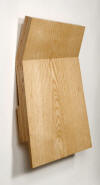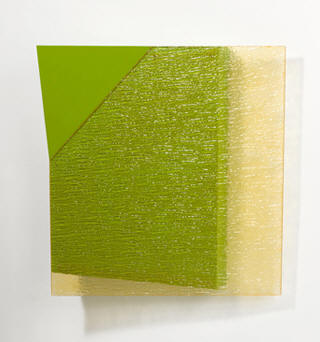> ARTIST INFORMATION
Presse
news
Aus den medien
PRESSESCHAU
ART FORUM UTE BARTH
Gallery for Modern & Contemporary
Art, Zurich
Richard Bottwin
Bildhauer, Maler, Objekt-Künstler
*1950, lebt und arbeitet in New York
Born 1950, lives and works in New York
CAPTURING DIMENSIONS
Vernissage Samstag, 20. März 2010 12 - 15 Uhr
Opening Reception Saturday March 20 12 am - 3 pm
Der in New York lebende Künstler Richard Bottwin arbeitet in seinen neusten Werken mit massiven Holzplatten und Acryl bemalten Holzoberflächen. Die teils parallele teils asymmetrische Anordnung der Bauteile zueinander verleihen Bottwins Objekte ein Gefühl der Bewegung und Unruhe, welches den statischen Holzplatten eine Leichtigkeit und Dynamik verleiht.
Architecture and functional objects inform the vocabulary of the New York artist Richard Bottwin’s work. The planes of the birch plywood sculptures, folding inward, parallel to each other, or lying flat against the wall, change alignments and seem to move as one walks around them.
The surfaces, laminated with wood veneers or painted with acrylic colours, reveal surprising shapes and patterns with shifts in the viewer’s perspective.A sense of disorientation, implied weightlessness and the element of surprise is created by the reductive forms and subvert the modernist vocabulary of the simple constructions.
Artist's Statement:
”In my work I enjoy creating paradoxes and unexpected relationships that reveal themselves during the visual progression around the sculptures. Using a vocabulary of forms that refer to architecture, my intent with the wall pieces is to present something apparently straightforward and predictable. Then I like to subvert the initial perception with the inference of kinetic activity and weightlessness. The sculptures are painted with primary colors that have been pushed to be slightly "off." Barely perceptible violets are laid down under dense blue glazes. Yellows push toward green or orange. Reds may have a violet or orange cast. The desired result of this manipulation of form, color and gravity is an experience that is at once slightly disorienting, amusing, and mysterious.”Richard Bottwin
Richard Bottwin, Facade #5, 2009
Wood, Acrylic Paint, Textured Acrylic Sheet
15 x 15 x 4.5 inches“Brent: As a sculptor you work fairly pure, neither adorning pieces with mounts nor placing your presentations on pedestals. If a “work” sits on the floor and only grows to somewhere around or below the knees, well, that is where it sits.
You suspend. In this case the body becomes very aware of its own mechanisms; how it values weight, position; how this operates within the sense of the temporal.
Smaller scale: The eye moves in and latches onto visual sensations that convince, though also deceive. And while no guesswork is needed to place the vocation in the realm of the sculptural there is a question to whether the form adds more, or if there is more to what there is?
Richard: My very early freestanding sculptures, although stable, looked like they were always about to fall over. Now I strive to make it very difficult to get a vertical fix on what you’re looking at. Walk around them and any expectations you had during your first scan will be subverted. Some recent pieces create a slight sense of anxiety in my gut when I look at them. Not a panic response exactly, more fun than that. Confronting a human-scaled construction that is standing on the floor, does engage the body of the viewer as you suggest. In contrast to this, I have found that the import of gravity is not such a big deal in small, pedestal size pieces. Maybe that’s why I moved them to the wall and used them to explore other issues long ago.
I’ve always been suspect of the conventional “modern art” solutions to gravity; Sculpture on a pad, sculpture on a stick, sculpture on a hidden pad (underground) and sculpture hanging on a wire doesn’t interest me. I like things to stand alone, solidly on the ground without artifice. Recently, I’ve been very conscious of wanting the things to stand in a thoroughly inevitable way, like junk casually left on a construction site. This allows the environment to intrude upon the sculpture and the sculpture to engage the environment.
The environment may be the “More” in your question. I’d like to have several sculptures in an installation working together, or, a single built environment one can enter that remove the viewer from this reality. I’ve always been moving toward architecture and have brushed up against it a few times. I feel like I’m collecting information to eventually build a pavilion or a “house” of some sort again as I did a few times in the past.
One vice I have is a passion for the decorative. For a brief period, around 20 years ago, I threw 22k gold leaf on my sculptures and sometimes glazed it with color. I learned a lot about pigments and transparency that way and then got over it. Now, I employ that love of decorative surface to create allusions to functionality. Veneers make the sculptures look like furniture and that confuses expectations. Figuration in a veneer also initiates visual activity that I can play with in the form of the sculpture…”
weitere Werke finden Sie in der Galerie in Zürich
wenn Sie mehr wissen möchten, schicken Sie uns einfach ein Email
> ÖFFNUNGSZEITEN DER GALERIE
ART FORUM UTE BARTH
Galerie für Moderne & Zeitgenössische Kunst
Kartausstrasse 8 CH-8008 Zürich
Tel. +41 44 3802711
www.artforumutebarth.com
© Ute Barth




